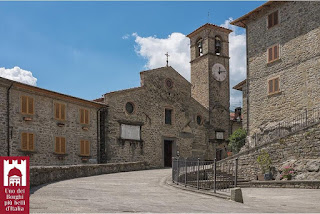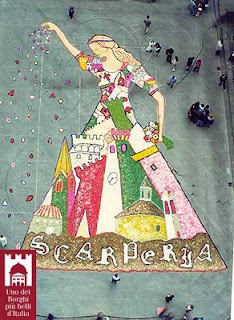Play on some of the best greens
With Tuscany’s picturesque rolling hills and mild climate, it is almost impossible to imagine a better place for golfing. The mild weather allows golfers to play no matter what the season.
Tuscany, has many certified golf courses, 18-hole courses and 9-hole courses. If you like to play golf, love open spaces and contact with nature, it is impossible not to remain fascinated by these places. These are the Golf Clubs in Tuscany with 18-holes courses.
Province of FLORENCE
Golf Club UGOLINO (18 holes par 72) Grassina
This is one of the oldest golf club’s in Italy in the heart of the Chianti vineyards. The natural contours of the Chianti slopes makes it an outstanding course, threaded through the vineyards, olive trees and maritime pines. The course is not long, but demands a high degree of skill. On Monday members only.
Golf Club CASTELFALFI (18 holes par 72) Montaione
 |
| Castelfalfi Golf Club |
Castelfalfi is the largest golf course in Tuscany. The courses, built according to the principles of sustainability and without adding anything artificial, are among the most fascinating from the point of view of its landscape and are stimulating from a sports point of view. The highest rated Golf Club in Tuscany and one of the best rated golf courts in Italy. Closed from January to late February.
Golf Club POGGIO DEI MEDICI (18 holes par 73) Scarperia
Poggio dei Medici Golf Club offers a top quality golf course not far from Florence. The golf course, set in the Mugello valley, sheltered by Apennines, offers 5 different starting tees for an exciting game for all levels. Frequent host of the Ladies Italian Open. On Monday members only. Handicap limit 36.
Province of PISTOIA
Golf MONTECATINI TERME (18 holes par 72) Monsummano Terme
The gently rolling slopes of the Montecatini golf course provide classic Tuscan panoramas. The course is thoroughly enjoyable, with a few tricky corners here and there but generally not too long or tough.
Province of PRATO
Golf Club LE PAVONIERE (18 holes par 72) Prato
 |
| Le Pavoniere Golf Club |
Hidden by the Tuscan hills behind the town of Prato, this course is full of water obstacles and irregular greens and it is known for its technical and landscape linearity. Le Pavoniere Golf Club occupies a part of what was once a de’Medici Estate and has all the charm and beauty you’d expect in Bella Toscana. One of the highest rated golf clubs in Tuscany.
Province of LUCCA
VERSILIA Golf Resort (18 holes par 71) Pietrasanta
This golf resort, in the heart of Versilia, is set between the mountains and the sea. It’s a pretty course, almost a botanical garden in some areas, the holes are quite tightly knit around the numerous lakes and streams that criss-cross the course. Handicap limit 54. Green Fees among the highest of Tuscany.
Province of PISA
COSMOPOLITAN Golf Club (18 holes par 72) Tirrenia
Nestled in the Tuscan pine forest, close to the sea just south of Pisa, the Cosmopolitan Golf Club has obstacles consisting of sand, dunes and lakes make the play very attractive from a technical point of view. On weekdays handicap limit 54. High rating.
Province of SIENA
CASTIGLION DEL BOSCO Golf Club (18 holes par 72) Castiglion del Bosco
The estate’s breathtaking 18-hole golf course was designed by the legendary winner of the British Open, Tom Weiskopf. It is designed to challenge the best of golfers and to thrill the casual golfers. It’s Italy’s only private club to be set within a UNESCO World Heritage Site. Members and hotel guests only. Extremely high green fees.
Royal Golf LA BAGNAIA (18 holes par 71) Bagnaia
 |
| Royal Golf La Bagnaia |
The course is a distinctive example of an inland links, which is enhanced by the charming lakes and imposing clubhouse that offers panoramic views across the towers of Siena. Even if still young La Bagnaia already hosted several national tournaments, like the 2013 Italian National Open Championship. Green Fees among the highest of Tuscany. Closed from 16 December to end of January. One of the highest rated golf clubs in Tuscany.
Province of GROSSETO
Golf Club PUNTA ALA (18 holes par 72) Punta Ala
The hilly course overlooks the sea and winds its way through pine trees, oaks and bushes. Those who love technical challenges won't be disappointed as this tricky course requires a lot of precision. Handicap limit 54. High rating.
TERME DI SATURNIA Golf Club (18 holes par 72) Saturnia
 |
| Terme di Saturnia Golf |
In the midst of the countryside, the green of the valley of Saturnia with its breathtaking landscape and the advanced tee markers at every hole, make your game of golf an unforgettable and truly exclusive experience. One of the highest rated golf clubs in Tuscany.
IL PELAGONE / GOLF CLUB TOSCANA (18 holes 71 par) Gavorrano
 |
| Il Pelagone Golf Club |
This 18-hole-golf course is arranged in the middle of vineyards and olive groves. Little lakes, water hazards and the Mediterranean fauna and flora give the course a very special charm. The view of Island Elba and Corsica from the 18th Tee is simply unforgettable. High rating.
ARGENTARIO Golf Club (18 holes 71 par) Porto Ercole
The Argentario Golf Club has a breathtaking view over the Orbetello Lagoon and the Tyrrhenian Sea. The course has been awarded the “Agri Cert” certification for its bio eco-compatibility, and all products used for its maintenance are completely natural. Green Fees among the highest of Tuscany. High rating.
Tuscany Holiday homes Farmhouse with horses in Gavorrano
Tuscany Holiday homes Farmhouse with horses in Gavorrano





























